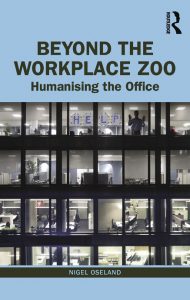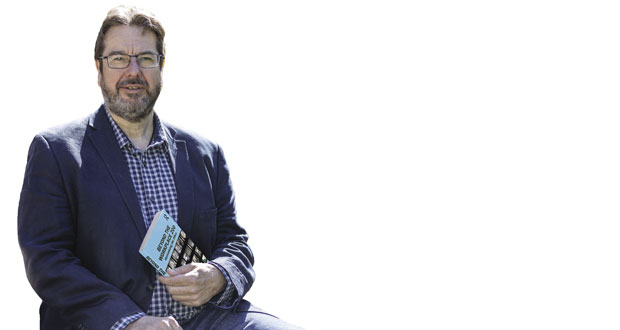CHANGING WORK
The recent Workplace Trends: A New World of Work conference, which was co-founded by Oseland, concluded that there is currently a once in a generation opportunity to reinvent work and the workplace, but the danger is that the moment will pass.
Says Oseland: “One of the few benefits of COVID is that it offers a golden opportunity to rethink office space and address the balance of space. If people aren’t coming in five days a week, you can reduce the desk space and open up areas to make the workplace more attractive to people.
“However, my biggest concern is when you look at surveys being published on the ‘future of the office’ there is still a corporate real estate view that is highly focused on reducing space and saving money. The thinking is, ‘if we’re now hybrid working we can half our space and save even more money’. Yet for the last 20 years we’ve been densifying offices and squeezing people in, with little thought to the consequences for workers.
“There has to be a balance between cost and space versus wellbeing and performance. Unfortunately, the industry often focuses on the cost side, because they say they can’t measure performance and wellbeing. But my advice is not to look at one side of the equation without any idea of the consequences of what you’re doing.”
Designers are devising new ways of furnishing the office, for instance the number of pods being exhibited at the recent Workplace Design show suggests that this kind of individual take anywhere design solution may work as equally well in the office as at home.
“What I like about this approach,” says Oseland, “is that even in an open plan environment you can start to create zones, with areas for teamwork, collaboration and focused workspaces.”
He doesn’t predict any kind of return to the private office but the adoption of small pods and meeting booths which don’t have to be fully enclosed – like the carrels you see in libraries. It’s all a part of an acknowledgment that people have different requirements not just between individuals but even within a typical knowledge workers day.
“We’ve got to offer the choice and the flexibility,” says Oseland. “The skill is in working out the right balance, but we know that high density desking doesn’t work and nor does the private office. We need to provide a range of settings and let the occupants choose.
“So as hybrid working takes off it’s a good time to reconfigure the workplace, take out some of the desks, and introduce more flexible working as people are not so precious about individual set desks. For every desk you take away, reduce the density, don’t reduce the space but add in areas people will need.”
HOME WORK
There is growing realisation among workplace designers and managers that the office must now compete with the benefits of working from home. Research published by Leesman found that 82 per cent of employees felt their home environment enabled them to work productively; while just 63 per cent of employees believed that their workplace enabled them to do the same. But are reports of the demise of the office being overplayed? Oseland certainly thinks so.
“I think the office gives you a centre of gravity, where you can come together in a place that reinforces the culture, the branding, the vision, and the ethics of the organisation,” he says. “You can’t physically represent that at home or remotely. When you look at many of the more recent surveys, people are missing the social and collaborative aspect of working together as a team. That’s why you need a space where you can go into the office on certain days – for that whole unplanned mingling and serendipity aspect.”
He also argues that while people may say they’re more productive at home, working without distraction from colleagues, getting focused work done etc., this takes a rather short-sighted view. What could happen in the long run, in terms of creativity and innovation?
“Your long productivity and sustainability as an organisation require people to come together to generate ideas for new products or services or whatever your culture demands. That’s the bit we’re missing out on, not being part of a body and working in tandem on the objectives of the organisation.”
However, an additional complication is in working out which days people come into the office, as Oseland believes implementing a rota grates against the whole idea of the flexibility of agile working. This is where good data comes into play.
He explains: “If you collect the evidence and get the data right you can prepare for this and you don’t have to demand staff come in every day. I always tell clients that they should have one day a week when all their team is in and arrange this for a Monday or Friday, which helps balance the use of the space out over the week.
“Part of the principles of agile working means that people will start to work out for themselves when they’ve got to come into the office, for instance if they’ve got to finish a report and need to work without the distractions of home, or if they just want to be seen and want to connect. Working from home too often is tiring as it’s too full on, with no natural breaks built into the day.”
ROLE OF FM
Now that the centre of gravity has moved away from the office, the FM sector has to acknowledge that the scale of a workplace should no longer be represented by a number of desks it can contain.
 “The desk is a small part of the workplace now, it’s still essential for some roles but for a lot of the high-end corporates the desk is a small part of what makes the office attractive, which includes the services and facilities. For FMs, it’s also about how they can support people at home and on the move, and their organisation’s hybrid work pattern could be a mixture of a dedicated office and membership of a co-working space.
“The desk is a small part of the workplace now, it’s still essential for some roles but for a lot of the high-end corporates the desk is a small part of what makes the office attractive, which includes the services and facilities. For FMs, it’s also about how they can support people at home and on the move, and their organisation’s hybrid work pattern could be a mixture of a dedicated office and membership of a co-working space.
“FMs also have to recognise that their remit is now much broader than it ever was and to accept that they can’t do it on their own, they’ll need to work with HR and IT. My advice would be not to be passive about this, it’s not about FM responding to the corporate need, it’s more about advising and leading the way. Look at the research, go to the conferences, find out what other organisations are doing, and start to devise a strategy. Too often FMs take a passive responder’s mode not an active leader’s, yet they’re in a unique position to lead.
“FMs also need to break free from an obsession with cost and reducing space. This is not the FM main remit – it shouldn’t be about managing space in order to reduce it but about managing space to help improve the performance of the organisation and its people. That’s how you get on the top table, from moving from being a supplier to being an adviser and a leader.”
Beyond the Workplace Zoo – Humanising the Office https://bit.ly/3r5qCUp





